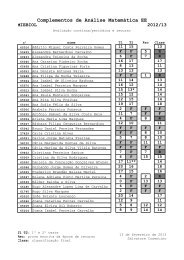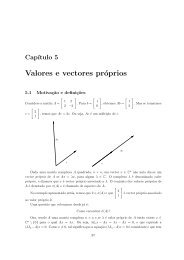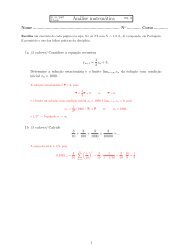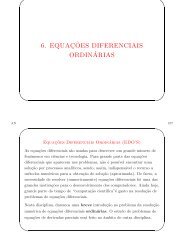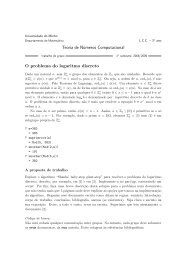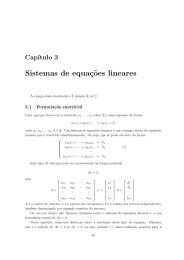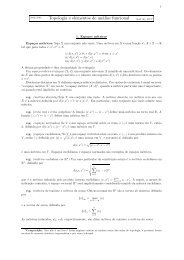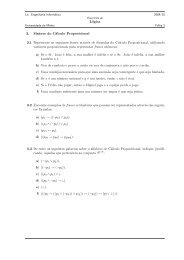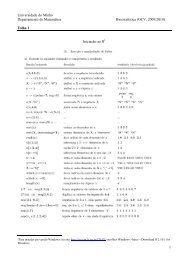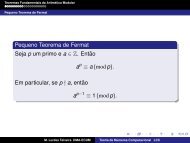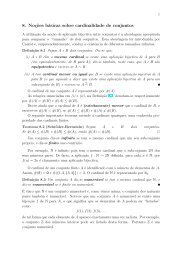My title - Departamento de Matemática da Universidade do Minho
My title - Departamento de Matemática da Universidade do Minho
My title - Departamento de Matemática da Universidade do Minho
You also want an ePaper? Increase the reach of your titles
YUMPU automatically turns print PDFs into web optimized ePapers that Google loves.
2 ITERATION/RECURSION 10<br />
2.3 Fibonacci numbers<br />
Fibonacci problem. Consi<strong>de</strong>re o seguinte problema, posto por Leonar<strong>do</strong> Pisano (mais conheci<strong>do</strong><br />
como Fibonacci, ou seja, “filius Bonacci”) no seu Liber Abaci, 1202:<br />
Quot paria coniculorum in uno anno ex uno pario germinentur.<br />
Qui<strong>da</strong>m posuit unum par cuniculorum in quo<strong>da</strong>m loco, qui erat undique pariete circun<strong>da</strong>tus,<br />
ut sciret, quot ex eo paria germinarentur in uno anno: cum natura eorum sit<br />
per singulum mensem aliud par germinare; et in secun<strong>do</strong> mense ab eorum natiuitate<br />
germinant. 4<br />
Fibonacci numbers. A resposta <strong>de</strong> Leonar<strong>do</strong> Pisano consiste no seguinte mo<strong>de</strong>lo. Se f n o<br />
número <strong>de</strong> pares <strong>de</strong> coelhos no n-ésimo mês, então<br />
f n+1 = f n + f n−1 .<br />
Esta é uma “lei” que prescreve recursivamente os valores <strong>do</strong>s f n <strong>da</strong><strong>do</strong>s uns valores iniciais f 0 e f 1 .<br />
The sequence grows quite fast, as you can see:<br />
1, 1, 2 , 3, 5, 8, 13, 21, 34, 55, 89, 144, 233, 377, 610, 987, 1597, 2584 , . . .<br />
and the numbers soon become astronomically large. For example, after 10 years we get<br />
larger than the Avogadro number!<br />
f 120 ≃ 8.67 × 10 24 ,<br />
Quotients and the growth of Fibonacci numbers. How fast <strong>do</strong> Fibonacci numbers grow<br />
Seja q n = f n+1 /f n o quociente entre sucessivos números <strong>de</strong> Fibonacci. Os quocientes satisfazem a<br />
equação recursiva<br />
q n+1 = 1 + 1/q n<br />
We compute:<br />
1 , 2 , 3/2 = 1.5 , 5/3 ≃ 1.66666 , 8/5 = 1.6 , 13/8 = 1.625 , 21/13 ≃ 1.61538 , . . .<br />
A sucessão <strong>do</strong>s q n converge (uma <strong>de</strong>monstração não é difícil, e será <strong>da</strong><strong>da</strong> mais a frente), ou seja,<br />
q n → φ se n → ∞. Ao passar ao limite na equação recursiva temos que φ = 1 + 1/φ, e portanto φ<br />
é uma raiz (positiva) <strong>do</strong> polinómio x 2 − x − 1, ou seja,<br />
φ = 1 + √ 5<br />
2<br />
≃ 1.6180339887498948482 . . .<br />
Hence, for large values of n we may approximate Fibonacci law as<br />
f n+1 ≈ φf n ,<br />
an exponential growth with rate φ. In particular, we expect f n ∼ φ n .<br />
The “ratio”. The limit φ is another famous irrational, the Greeks’ “ratio/proportion”. As<br />
<strong>de</strong>scribed by Euclid: 5<br />
“A straight line is said to have been cut in extreme and mean ratio when, as the whole<br />
line is to the greater segment, so is the greater to the less.”<br />
4 Quantos pares <strong>de</strong> coelhos po<strong>de</strong>m ser gera<strong>do</strong>s por um par em um ano.<br />
Alguém tem um par <strong>de</strong> coelhos, em um lugar inteiramente fecha<strong>do</strong>, para <strong>de</strong>scobrir quantos pares <strong>de</strong> coelhos po<strong>de</strong>m<br />
ser gera<strong>do</strong>s <strong>de</strong>ste par em um ano: por natureza, ca<strong>da</strong> par <strong>de</strong> coelhos gera ca<strong>da</strong> mês outro par, e começa a procrear<br />
a partir <strong>do</strong> segun<strong>do</strong> mês após o nascimento.<br />
5 Euclid, Elements, Book VI, Definition 3.



